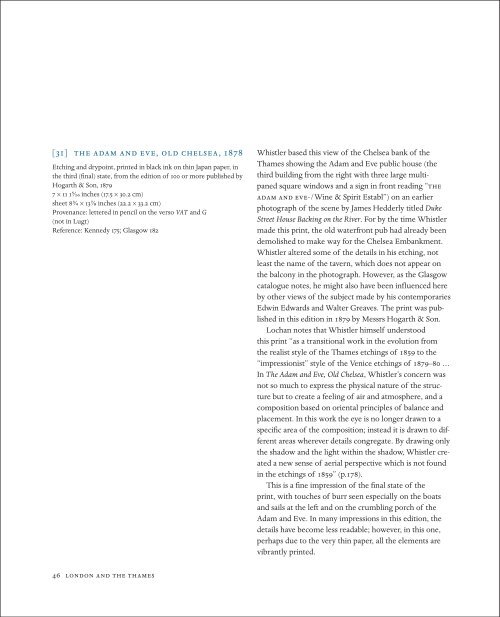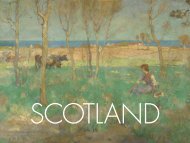Create successful ePaper yourself
Turn your PDF publications into a flip-book with our unique Google optimized e-Paper software.
[31] The Adam and Eve, Old Chelsea, 1878<br />
Etching and drypoint, printed in black ink on thin Japan paper, in<br />
the third (final) state, from the edition of 100 or more published by<br />
Hogarth & Son, 1879<br />
7 x 11 15/16 inches (17.5 x 30.2 cm)<br />
sheet 8 3/4 x 13 7/8 inches (22.2 x 33.2 cm)<br />
Provenance: lettered in pencil on the verso VAT and G<br />
(not in Lugt)<br />
Reference: Kennedy 175; Glasgow 182<br />
Whistler based this view of the Chelsea bank of the<br />
Thames showing the Adam and Eve public house (the<br />
third building from the right with three large multipaned<br />
square windows and a sign in front reading “THE<br />
ADAM AND EVE-/Wine & Spirit Establ”) on an earlier<br />
photograph of the scene by James Hedderly titled Duke<br />
Street House Backing on the River. For by the time Whistler<br />
made this print, the old waterfront pub had already been<br />
demolished to make way for the Chelsea Embankment.<br />
Whistler altered some of the details in his etching, not<br />
least the name of the tavern, which does not appear on<br />
the balcony in the photograph. However, as the Glasgow<br />
catalogue notes, he might also have been influenced here<br />
by other views of the subject made by his contemporaries<br />
Edwin Edwards and Walter Greaves. The print was published<br />
in this edition in 1879 by Messrs Hogarth & Son.<br />
Lochan notes that Whistler himself understood<br />
this print “as a transitional work in the evolution from<br />
the realist style of the Thames etchings of 1859 to the<br />
“impressionist” style of the Venice etchings of 1879–80 …<br />
In The Adam and Eve, Old Chelsea, Whistler’s concern was<br />
not so much to express the physical nature of the structure<br />
but to create a feeling of air and atmosphere, and a<br />
composition based on oriental principles of balance and<br />
placement. In this work the eye is no longer drawn to a<br />
specific area of the composition; instead it is drawn to different<br />
areas wherever details congregate. By drawing only<br />
the shadow and the light within the shadow, Whistler created<br />
a new sense of aerial perspective which is not found<br />
in the etchings of 1859” (p.178).<br />
This is a fine impression of the final state of the<br />
print, with touches of burr seen especially on the boats<br />
and sails at the left and on the crumbling porch of the<br />
Adam and Eve. In many impressions in this edition, the<br />
details have become less readable; however, in this one,<br />
perhaps due to the very thin paper, all the elements are<br />
vibrantly printed.<br />
46 london and the thames



